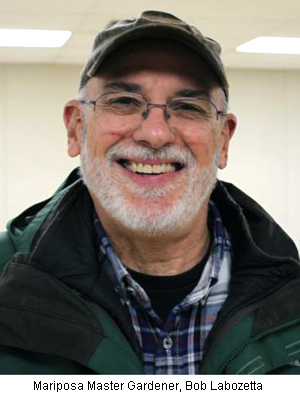January 19, 2018 - In the last article of OtGF, we covered the proper techniques for planting bare root fruit and nut trees. If you have not yet, now is the time to prune such trees. By pruning at the time of planting (or close to it), you will more easily shape it to a desirable structure that will encourage better fruit production and help prevent broken limbs in the future.
There are three basic pruning systems: the open center or vase, modified central leader, and central leader.
Open center is a traditional shape for almond, apricot, cherry, fig, nectarine, olive, peach, pear, persimmon, plum & pomegranate trees. It is a simple shape for beginning orchardists to prune and lets plenty of light in to the open center, but results in weak branches that will require props when bearing fruit and possibly heavy shade from upper limb leaves.
For early year pruning of the open center, the University of California “The Backyard Orchardist” recommends:

● In the first year select three to four limbs distributed evenly around trunk. Leave small branches on these limbs for early fruiting and sunburn protection. Head limbs half their length, should be 24-30".
● At the second year select one or two limbs on each primary. Head these back to ½ their length (24-30"). Remove other limbs.
Central leader is very successful for apple, pear, persimmon, and pecan trees. It resembles the Christmas tree shape - conical and tapered. Because light and air circulation are improved with this shape, fruit production is maximized. Unless tree size is limited to 12 ft. to 15 ft., this shape is impractical for home orchards. For early year pruning of the central leader, the University of California “The Backyard Orchardist” recommends:
● After first year select three to five lateral branches, lowest about 12-15" above ground, spaced evenly around tree, two to three feet apart vertically. Head leader and laterals that may compete with leader.
● Following years develop another series of laterals every two to three feet higher up the central leader. It will likely be necessary to spread laterals physically when five to six feet long in order to form a proper angle (about 45°) with the trunk.
Modified central leader is a compromise between the two shapes described above, can be used for a variety of trees, and may be advantageous to physically challenged home orchardists. It results in a sturdy trunk and central light, makes harvesting easier than the central leader shape, and creates stronger branches than the open tree. It seems to work very well in sunny climes of the Sierra foothills.
Now (winter) is a good time for pruning apple, pear, peach, and nectarine trees, but wait until summer to prune apricot, cherry, and pluot trees. For more information on backyard orchards, see: homeorchard.ucanr.edu.
The Mariposa Master Gardeners are hosting a FREE Pruning Fruit Trees workshop on. Saturday, February 3, 2018, with UC Emeritus, Fruit and Nut advisor, Maxwell Norton, in Mariposa off Triangle Road. For more information and registration (needed to attend), go online at cemariposa.ucanr.edu or call (209) 966-2417.
For further gardening information and event announcements, please refer to the Mariposa Master Gardener website (cemariposa.ucanr.edu/Master_Gardener) and Facebook page (Mariposa Master Gardeners). UC Master Gardeners staff the help desk and phone helpline serving Mariposa County, including Greeley Hill, Coulterville and Lake Don Pedro (Phone: (209) 966-7078; Email:mgmariposa@ucdavis.edu).
Article by Bob Labozetta (Mariposa Master Gardener)








 (
(
